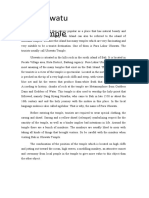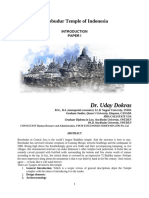Xak 1
Xak 1
Uploaded by
Solikhin MuhammadCopyright:
Available Formats
Xak 1
Xak 1
Uploaded by
Solikhin MuhammadOriginal Description:
Original Title
Copyright
Available Formats
Share this document
Did you find this document useful?
Is this content inappropriate?
Copyright:
Available Formats
Xak 1
Xak 1
Uploaded by
Solikhin MuhammadCopyright:
Available Formats
Pura Luhur (Uluwatu) Temple
Pura Luhur Uluwatu is one of Bali's kayangan jagat (directional temples) and guards Bali from evil spirits from the SW, in which dwell major deities, in Uluwatu's case; Bhatara Rudra, God of the elements and of cosmic force majeures. Bali's most spectacular temples located high on a cliff top at the edge of a plateau 250 feet above the waves of the Indian Ocean. Uluwatu lies at the southern tip of Bali in Badung Regency. Dedicated to the spirits of the sea, the famous Pura Luhur Uluwatu temple is an architectural wonder in black coral rock, beautifully designed with spectacular views. This is a popular place to enjoy the sunset. Famous not only for its unique position, Uluwatu also boasts one of the oldest temples in Bali, Pura Uluwatu. Most of Bali's regencies have Pura Luhur (literally high temples or ascension temples) which become the focus for massive pilgrimages during three or five day odalan anniversaries. The
photogenic Tanah Lot and the Bat Cave temple, Goa Lawah, is also Pura Luhur. Not all Pura Luhur are on the coast, however but all have inspiring locations, overlooking large bodies of water.
Pura Uluwatu is located on the cliff top close to the famous surf break on the SW of the Bukit peninsula. Empu Kuturan, a Javanese Hindu priest who built the tiered meru, founded the temple in the 10th century and a shrine here as well as at other key locations longs the Balinese coast. In the 15th Century the great pilgrim priest Dhang Hyang Dwijendra, who established the present form of Hindu-Dharma religion, chose Pura Uluwatu as his last earthly abode: history records that Dwijendra achieved moksa (oneness with the godhead, in a flash of blazing light) while meditating at Uluwatu. The temple is regarded, by Brahman's island wide, as his holy 'tomb'. Legend also tells us that Dwijendra was the architect of the beautiful temple, as well as many other major temples on Bali, Lombok and Sumbawa. In the 17th century Niratha also from Java came to Bali and built temples, adding to Uluwatu. Behind the main pagoda of Pura Uluwatu's small inner sanctum, a limestone statue of a Brahman priest surveys the Indian Ocean-it is said the statue represents the founding priest Dwijendra. Another shrine within the complex represents the boat on which Dwijendra traveled from, then, Hindu Java. According to legend he arrived at Pura Peti Tenget, north of Kuta. Uluwatu Beach is known for its surf and, in nearby hostelries, its full moon rage parties. It rages at the temple too but in an orderly way, thanks to the royal house of Puri Agung Jero Kuta, Denpasar, who are the temple's hereditary pangemong (custodians). Hundreds of nobles from this family, and many
You might also like
- Uluwatu TempleDocument4 pagesUluwatu TempleAri Listya DewiNo ratings yet
- Bali GuideDocument3 pagesBali Guideedo868687No ratings yet
- Besakih Temple in BaliDocument3 pagesBesakih Temple in Baliwella pramanaNo ratings yet
- ULUWATU Report TextDocument2 pagesULUWATU Report TextNaura RaraNo ratings yet
- ENGLISHDocument2 pagesENGLISHbikinibottom. universityNo ratings yet
- 6 Must-Visit Temples in Bali To Experience Bliss: 1 - Tanah Lot TempleDocument3 pages6 Must-Visit Temples in Bali To Experience Bliss: 1 - Tanah Lot TempleFarida SNo ratings yet
- Swayambhu NathDocument6 pagesSwayambhu NathJen PokharelNo ratings yet
- Bratan Lake and Ulun Danu Beratan TempleDocument5 pagesBratan Lake and Ulun Danu Beratan TemplesiennaNo ratings yet
- Structural Elements of BorobudurDocument101 pagesStructural Elements of BorobudurUday DokrasNo ratings yet
- Will You Walk With Me To BorobodurDocument98 pagesWill You Walk With Me To BorobodurUday DokrasNo ratings yet
- The Architecture of Borobudur TempleDocument3 pagesThe Architecture of Borobudur TempleCynthia Dhyaa NNo ratings yet
- Borobudur ScriptDocument2 pagesBorobudur Scriptdarrensimone9No ratings yet
- H o U S eDocument6 pagesH o U S eArul Ananda PrabuNo ratings yet
- The Circular Nature of Rakai Pinkaton StructuresDocument26 pagesThe Circular Nature of Rakai Pinkaton StructuresUday DokrasNo ratings yet
- Cinnamon Route and The Adi Buddha at BorobudurDocument27 pagesCinnamon Route and The Adi Buddha at BorobudurUday DokrasNo ratings yet
- Hermeneutics and Phenomenology of BorobudurDocument46 pagesHermeneutics and Phenomenology of BorobudurUday DokrasNo ratings yet
- Paper Dinda Nurjannah 203106018Document9 pagesPaper Dinda Nurjannah 203106018nico putraNo ratings yet
- Comparison Between Site Plans of Angkor Wat and Borobudur TempleDocument44 pagesComparison Between Site Plans of Angkor Wat and Borobudur TempleUday DokrasNo ratings yet
- Walking in The Footsteps of BuddhaDocument13 pagesWalking in The Footsteps of BuddhaAngie LeongNo ratings yet
- Indic BuddhismDocument15 pagesIndic BuddhismMin Bahadur shakyaNo ratings yet
- Religious Places in S.LDocument11 pagesReligious Places in S.Lpriyantha dasanayakeNo ratings yet
- Compare Borobudur and SanchiDocument17 pagesCompare Borobudur and SanchiUday DokrasNo ratings yet
- A Home For KUBERA The Powan Temple of YogakartaDocument43 pagesA Home For KUBERA The Powan Temple of YogakartaUday DokrasNo ratings yet
- Sekolah Tinggi Teologi JakartaDocument1 pageSekolah Tinggi Teologi JakartaEdward DanielNo ratings yet
- Sceneries in IndonesiaDocument4 pagesSceneries in IndonesiaJazzer SalazarNo ratings yet
- Sightseeing Tours: Beautiful Kintamani (Batur Volcano)Document5 pagesSightseeing Tours: Beautiful Kintamani (Batur Volcano)mirawati galuhNo ratings yet
- Analiysis BorobudurDocument10 pagesAnaliysis BorobudurArtika WulandariNo ratings yet
- Monkey Temple (Swayambhunath) - A Virtual Tour of One of the Most Sacred Buddhist Pilgrimage Sites in the WorldFrom EverandMonkey Temple (Swayambhunath) - A Virtual Tour of One of the Most Sacred Buddhist Pilgrimage Sites in the WorldNo ratings yet
- Borobudur - BIG BUDDHA - As A Complete Exposition of DoctrineDocument12 pagesBorobudur - BIG BUDDHA - As A Complete Exposition of DoctrineudayNo ratings yet
- Borobudur Temple of IndonesiaDocument21 pagesBorobudur Temple of IndonesiaUday DokrasNo ratings yet
- Candi BorobudurDocument19 pagesCandi BorobudurlaelaNo ratings yet
- Buddha Uhr, Meaning The Buddhist Monastery On The Hill. Borobudur Temple IsDocument6 pagesBuddha Uhr, Meaning The Buddhist Monastery On The Hill. Borobudur Temple IsAnggitaNo ratings yet
- BorobudurDocument20 pagesBorobudurUday Dokras100% (1)
- Lumibini A Fountain of PeaceDocument29 pagesLumibini A Fountain of PeaceMin Bahadur ShakyaNo ratings yet
- LumbiniDocument15 pagesLumbiniGaurab PaudelNo ratings yet
- The Blueprint For BorobudurDocument10 pagesThe Blueprint For BorobudurUday DokrasNo ratings yet
- Borobudur TempleDocument3 pagesBorobudur TemplenissabriyaNo ratings yet
- Celuk VillageDocument40 pagesCeluk VillageArdhi PutraNo ratings yet
- Sri Ramakrishna and His Disciples in OrissaDocument124 pagesSri Ramakrishna and His Disciples in OrissaEstudante da Vedanta100% (4)
- Desa SingapaduDocument8 pagesDesa SingapaduTri MentariNo ratings yet
- Pinhole Camera TempleDocument11 pagesPinhole Camera TempleUday DokrasNo ratings yet
- Lumbini The Birthplace of Buddha in NepalDocument2 pagesLumbini The Birthplace of Buddha in NepalSantosh TimilsinaNo ratings yet
- The Ploysemic Form of The BorobudurDocument7 pagesThe Ploysemic Form of The BorobudurUday DokrasNo ratings yet
- Large Base StupasDocument60 pagesLarge Base StupasUday DokrasNo ratings yet
- Bapuon and OrissaDocument12 pagesBapuon and OrissaudayNo ratings yet
- 12 Fascinating TemplesDocument11 pages12 Fascinating TemplesDayanand MungraNo ratings yet
- Design Elements of Buddhist BorobudurDocument38 pagesDesign Elements of Buddhist BorobudurUday DokrasNo ratings yet
- Description WPS OfficeDocument2 pagesDescription WPS Officeadindanur302No ratings yet
- Mandala in BorobudurDocument53 pagesMandala in BorobudurUday DokrasNo ratings yet
- Tushita Heaven in Buddhist CosmologyDocument16 pagesTushita Heaven in Buddhist CosmologyUday DokrasNo ratings yet
- Bali Info Monkey Forest UbudDocument3 pagesBali Info Monkey Forest UbudindigenousbaliNo ratings yet
- Bali 5N6DDocument2 pagesBali 5N6DoperationsNo ratings yet
- SoJiwan TempleDocument5 pagesSoJiwan TempleUday DokrasNo ratings yet
- Borobudur Architectural BuddhismDocument2 pagesBorobudur Architectural BuddhismUday DokrasNo ratings yet
- Name:: I Kadek Roma Saputra (24) I Komang Romi SaputraDocument8 pagesName:: I Kadek Roma Saputra (24) I Komang Romi SaputraTinnyThinie Che T'ndNo ratings yet
- Adornments at BorobodurDocument18 pagesAdornments at BorobodurUday DokrasNo ratings yet
- Members: Anggun Putri Sulasmi Arlie Mowrent Vernanda Raja Dhita Vannesia Rizki Maysarah Class: X Iis 3Document6 pagesMembers: Anggun Putri Sulasmi Arlie Mowrent Vernanda Raja Dhita Vannesia Rizki Maysarah Class: X Iis 3Diandra Febri UtamiNo ratings yet
- KalpakDocument6 pagesKalpakTanvi RaneNo ratings yet
- Tirtha Campuhan: Karya Komposisi Baru Dengan Media Gamelan Semar PagulinganDocument9 pagesTirtha Campuhan: Karya Komposisi Baru Dengan Media Gamelan Semar PagulinganRobin MakmurNo ratings yet
- Unit 7Document3 pagesUnit 7Mahmud Rîkîmãrü BadarudinNo ratings yet
- 29. Đề Thi Thử TN THPT 2021 - Môn Tiếng Anh - Bộ Đề Chuẩn Cấu Trúc Minh Họa - Đề 29 - File Word Có Lời GiảiDocument21 pages29. Đề Thi Thử TN THPT 2021 - Môn Tiếng Anh - Bộ Đề Chuẩn Cấu Trúc Minh Họa - Đề 29 - File Word Có Lời GiảiTrần Đức MạnhNo ratings yet
- Contoh Recount TextDocument18 pagesContoh Recount TextAva DanunkNo ratings yet
- Tourism and Cultural Change in Bali 2.0Document24 pagesTourism and Cultural Change in Bali 2.0I Made Bram SarjanaNo ratings yet
- Konsep Soal SAS Kelas XDocument13 pagesKonsep Soal SAS Kelas XSAIFUL ATHOKNo ratings yet
- Table of Transportation Price List: Pick Up Drop Nett Price Pick Up Drop Nett PriceDocument2 pagesTable of Transportation Price List: Pick Up Drop Nett Price Pick Up Drop Nett PricePutu Eka Jaya WirawanNo ratings yet
- PENILAIAN HARIAN I KLS XII BARU Pdf-Edited-Edited-Edited-Edited-Edited-Edited-Edited-EditedDocument8 pagesPENILAIAN HARIAN I KLS XII BARU Pdf-Edited-Edited-Edited-Edited-Edited-Edited-Edited-EditedAsri100% (1)
- 6 Indonesian Adventure Travel Destination - ENGDocument106 pages6 Indonesian Adventure Travel Destination - ENGbobomurodfayziyev97No ratings yet
- Artikel Bahasa Inggris Budaya Pulau BaliDocument2 pagesArtikel Bahasa Inggris Budaya Pulau BaliAhmad Efendi100% (1)
- Wonderful Indonesia - A Destination Like No OtherDocument3 pagesWonderful Indonesia - A Destination Like No OtherFauziNo ratings yet
- 2013 Engleză Etapa Pe Scoala Rezultate 0Document6 pages2013 Engleză Etapa Pe Scoala Rezultate 0Paul GalanNo ratings yet
- A Trip To JogjakartaDocument8 pagesA Trip To JogjakartaNiky BahteraNo ratings yet
- PTS RecountDocument20 pagesPTS RecountRidwan RidwanNo ratings yet
- Colin McPhee Balinese Ceremonial - A283 PDFDocument2 pagesColin McPhee Balinese Ceremonial - A283 PDFDolfiParthaHutagalungNo ratings yet
- Penawaran Dedicated Business Wireless - Bapak Hasan PDFDocument5 pagesPenawaran Dedicated Business Wireless - Bapak Hasan PDFAditya LukazNo ratings yet
- Bali 5 NightDocument2 pagesBali 5 NightTanzim AhmedNo ratings yet
- NIP NamaDocument730 pagesNIP NamaKetut SuwendraNo ratings yet
- BALI - Jadwal-SKDDocument33 pagesBALI - Jadwal-SKDikomang tri sukraningratNo ratings yet
- Tugas Bahasa InggrisDocument5 pagesTugas Bahasa InggrisQonitahNo ratings yet
- Gus Teja BiographDocument2 pagesGus Teja BiographGalih Putri WNo ratings yet
- Contoh Soal BasingDocument23 pagesContoh Soal Basingnur azizahNo ratings yet
- Javanese Understanding Indic CalendarDocument48 pagesJavanese Understanding Indic Calendarrakawi padeleganNo ratings yet
- Pat B Inggris 8 Utama Bahasa InggrisDocument9 pagesPat B Inggris 8 Utama Bahasa Inggrisdwi watiNo ratings yet
- Bali Indonesia Quotation MDM Zenaida PDFDocument5 pagesBali Indonesia Quotation MDM Zenaida PDFZenaida C. LorNo ratings yet
- Rafi Al AzharDocument15 pagesRafi Al AzharD RaNo ratings yet
- Rundown Micro Full 4-6 Nov 22Document1 pageRundown Micro Full 4-6 Nov 22alifyaaadzanaNo ratings yet
- Bhs. Inggris 10 Semua JurusanDocument6 pagesBhs. Inggris 10 Semua JurusanJica LhaqNo ratings yet
- Ria SekarangDocument23 pagesRia Sekaranglia sholichaNo ratings yet
- Indonesi A: Group 1Document25 pagesIndonesi A: Group 1AllaineF.MargesNo ratings yet

























































































